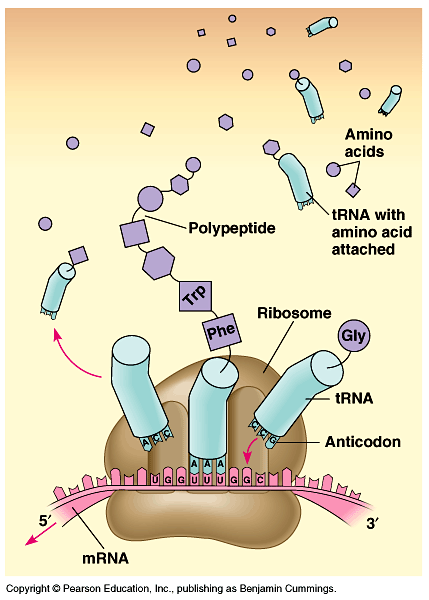Sunday, 29 March 2015
Sunday, 1 March 2015
Translation
Act I: Initiation
Act II: Elongation
Act III: Termination
- The mRNA comes to the cytoplasm, with a starting codon AUG.
- A small ribosomal subunit binds to mRNA. The ribosome has two ribosomal units (small and large).
- The first tRNA carrying a specific amino acid, met, at one end and having a specific nucleotide triplet, anticodon, UAC, at the other end comes to bind to the starting codon.
- The ribosome also has one site for binding of mRNA and three sites for the binding of tRNA (P site, A site, E site).
- A site: new tRNA with next amino acid to be added to the chain.
- P site: holds growing polypeptide chain.
- E site: discharged tRNA which will return to cytoplasm and pick up designated amino acid.
- Initiation factors brings the large ribosomal subunit to mRNA, placing the tRNA in the P site.
Act II: Elongation
- Another tRNA carrying amino acid recognizes its corresponding codon at the A site.
- An RNA molecule catalyzes the formation of a peptide bond between the polypeptide in the P site with the new amino acid in the A site.
- The polypeptide chain is transferred to the tRNA at the A site.
- The ribosome moves the tRNA with the attached polypeptide from the A site to the P site. This process need energy provided by GTP.
- The first tRNA enters the E site, and as the third tRNA attaches to the A site, it exits the E site to the cytoplasm to pick another amino acid.
Act III: Termination
- When one of the three stop codons UAG, UAA, UGA reaches the A site, a release factor cut the bond between the polypeptide chain and its tRNA at the P site.
- Polypeptide, which is known as protein, is released.
- Translation complex disassembles.
Transcription
Transcription is the copying of a sequence of DNA to produce a complementary strand of RNA
Act I: Initiation
Act I: Initiation
- Transcription factors recognize promoter regions (TATA box) on the template and bind to the promoters.
- This signals RNA polymerase II to bind to transcription factors. Together they form a transcription initiation complex.
- Polymerase II starts transcription.
Act II: Elongation
- RNA polymerase unwinds DNA double helix and adds RNA nucleotides to the 3' end of the growing strand. RNA, same as DNA, grows from 5' to 3'.
- When adding the complimentary nucleotides to the RNA transcript, every thymine is replaced by uracil.
- As RNA polymerase II moves forward, the double helix behind re-forms, and the newly transcribed RNA molecule, RNA transcript, peels away.
- The strand that RNA reads is called the template strand/ antisense strand.
- The strand that has exactly same sequence as RNA is called coding strand/ sense strand.
- A single gene can be transcribed by multiple polymerase simultaneously.
Act III: Termination
- Transcription stops when RNA polymerase transcribes as a terminator AAUAA.
- The pre-mRNA is cut, and RNA polymerase II is released form the DNA.
- In eukaryotic cells, before the mRNA enter the cytoplasm, enzymes work on modifying them.
- G-cap (modified guanine) is assed to the 5' end of pre-mRNA.
- PolyA-tail is added to the 3' end of pre-mRNA.
- Pre-mRNA combines with snRNPs and other proteins to form a spliceosome.
- The snRNA in the snRNPs base pair with nucleotides at the end of the noncoding segments on the pre-mRNA, introns.
- Introns are excised from the pre-mRNA, then the coding regions, exons, are spliced together in the spliceosome.
- The snRNA acts as a ribozyme, and the RNA acts as an enzyme.
- The spliceosome comes apart, releasing mRNA.
Subscribe to:
Comments (Atom)






